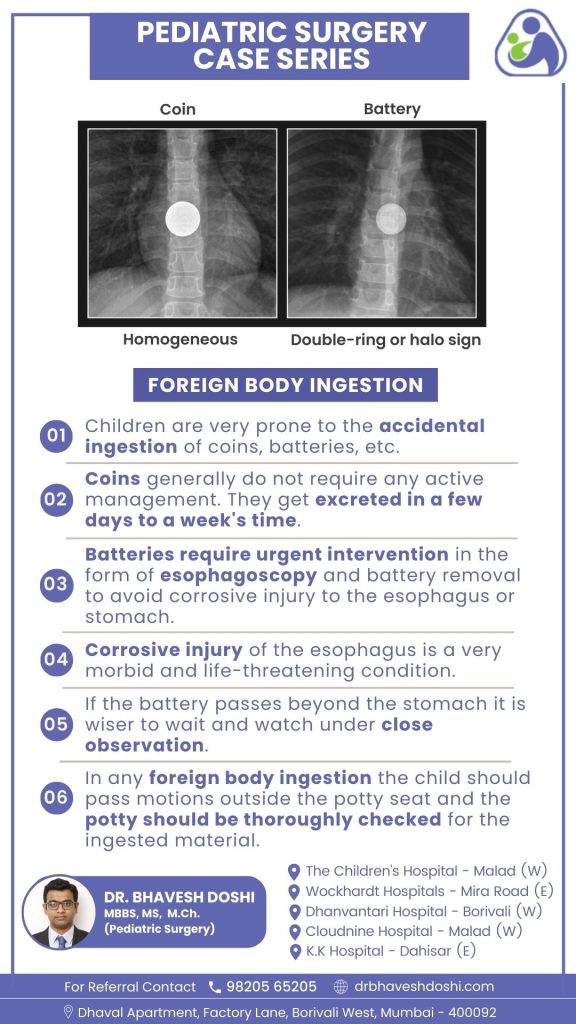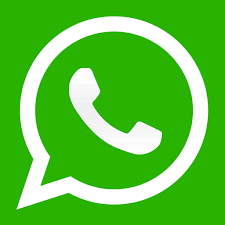Foreign Body Ingestion
Sometimes, kids accidentally swallow things, and it can also happen on purpose. Most of the time, it involves small stuff like coins. Children are very prone to the accidental ingestion of coins, batteries, etc.
Button or disc batteries and coins can be a problem if they get stuck in places like the throat, nose, or ear, even if it’s just for a short time. The bigger lithium batteries are more risky, but all kinds can be dangerous. If you think a child swallowed a button or disc battery or a coin, it’s important to get help quickly. Especially if it’s stuck in the throat, it needs to be taken out right away.
Coins ingestion
In most cases, when a child swallows a coin, it usually doesn’t need any immediate action. The coin typically passes through the digestive system and is naturally expelled within a few days to a week. Generally, it’s a matter of waiting for the body to take care of it, and no specific intervention is needed.
Batteries ingestion
On the other hand, if a child swallows a battery, quick action is crucial. Batteries, especially button or disc batteries, can cause serious harm. Urgent intervention is necessary, usually in the form of esophagoscopy, to remove the battery promptly. This urgent action is vital to prevent corrosive injuries to the esophagus or stomach, which can be severe and even life-threatening.
Corrosive Injury
Corrosive injury to the esophagus is a highly serious and potentially life-threatening condition. When a battery is swallowed, the corrosive substances it contains can lead to significant damage if not promptly removed. This injury can result in complications such as tissue damage, inflammation, and even perforation of the esophagus. Timely intervention is critical to avoid these severe consequences and ensure the child’s safety and well-being.

What are the diagnostic options for foreign body ingestion?
- Initial Imaging– Plain radiographs are typically the initial imaging modality of choice, especially for metallic foreign bodies like coins and batteries.
- Observation for Healthy Children– Healthy children with recent, low-risk ingestions may be observed without immediate intervention.
- Metal Detectors Usage– Metal detectors may be occasionally used, particularly when there is a known coin ingestion.
- Incidental Findings– Unexpected foreign bodies may be discovered incidentally on radiographs obtained for non-specific symptoms like cough, fever, or weight loss.
- Visibility of Glass Fragments– Most glass fragments are visible on radiographs.
- Challenges with Radiolucent Objects– Radiolucent objects, such as large pieces of meat or plastic toys, may not be apparent on radiographs. However, their edges or irregularities may still be noticeable.
- Advanced Imaging Considerations– Patients with radiolucent objects may require advanced imaging techniques like contrast-enhanced radiography or MRI scanning.
What are the treatment methods to remove foreign body ingestion?
Battery Passage Beyond Stomach:
If a swallowed battery moves beyond the stomach, a cautious “wait and watch” approach is advisable, closely observing the child for safe passage.
Monitoring Bowel Movements:
In any foreign body ingestion, including batteries, it’s essential for the child to pass motions outside the potty seat. Caregivers should thoroughly check stool contents for signs of the ingested material, aiding in monitoring and decision-making for further management.
Spontaneous Passage:
Objects in the lower esophagus, especially at the gastroesophageal junction, may pass spontaneously into the stomach after a few hours. This is considered safe for coins and similar small, inert objects in children with normal GI tracts and low risk of complications.
Alternative Removal Techniques:
Some centers use techniques like bougie or balloon catheter for small esophageal foreign bodies, particularly coins. However, these methods require significant expertise.
Endoscopy for High-Risk Objects:
Large, sharp, pointed, or high-risk objects in the stomach are typically removed using endoscopy. It is also employed when continued passage through the GI tract poses a risk to the patient.
Lower GI Tract Objects:
Objects in the lower GI tract may require collaboration with a pediatrician, who may recommend surgical removal based on the specific circumstances.



